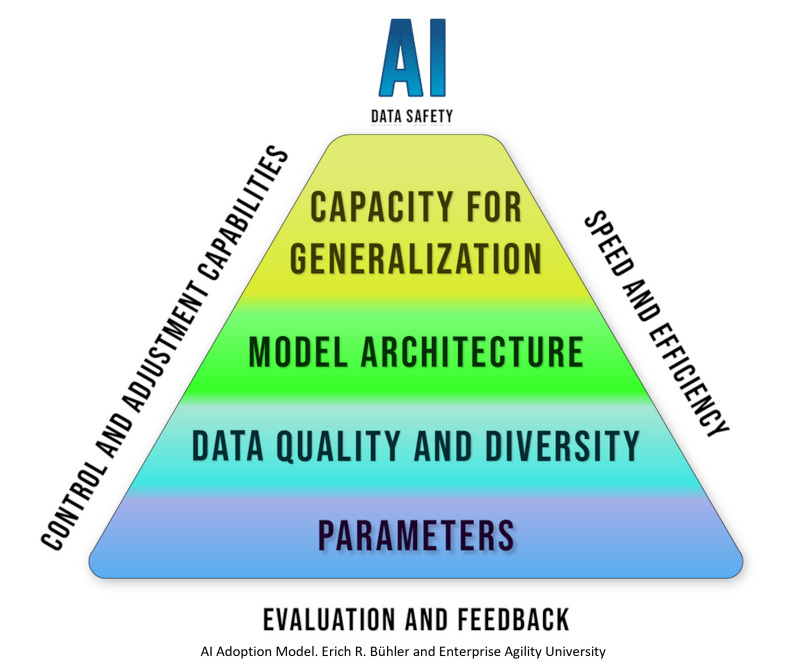Imagine you are building a house. You wouldn’t start with the roof, right? The same goes for adopting AI in your company. The AI Adoption Model is like a blueprint that helps you build a strong foundation for AI integration step by step.

At the base of our AI house, we have Parameters. These are like the settings on your smartphone — they control how the AI behaves. Just above that, we have Data Quality and Diversity. This is crucial because, just like humans, AI learns from experience. The more diverse and high-quality data we feed it, the smarter it becomes.
Moving up, we have Model Architecture. This is the brain of our AI, determining how it processes information. On top of that sits the Capacity for Generalization, which is the AI’s ability to apply what it’s learned to new situations. It is like teaching a child to read — we want them to understand new words, not just memorize a few books.
Now, let’s look at the sides of our AI house. On the left, we have Control and Adjustment Capabilities. This is our remote control, allowing us to fine-tune the AI’s performance. On the right, we have Speed and Efficiency because, in today’s fast-paced world, we need AI to keep up with demand.
At the bottom, outside our house, we have Evaluation and Feedback. This is like having a suggestion box that helps us continuously improve our AI based on real-world use.
Finally, at the very top, we have Data Safety. This is our roof, protecting everything inside. It ensures that the data we use to train our AI is secure and not misused. The benefits of using this model are enormous. First, it provides a clear roadmap for AI adoption, helping organizations like yours avoid common pitfalls. Second, it ensures that AI systems are built on a solid foundation of quality data and robust architecture. Finally because it emphasizes the importance of adaptability and continuous improvement.
Companies that use this model tend to have more successful AI implementations. They are able to create AI systems that are not only powerful but also trustworthy and aligned with their business goals. One of the most significant advantages I have seen is how this model helps bridge the gap between technical teams and business leaders. It provides a common language and framework that both sides can understand and work with.
Remember, adopting AI isn’t just about having the latest technology or best LLM– it is about integrating it in a way that truly benefits your organization. The AI Adoption Model helps you do just that, ensuring your AI investment pays off in the long run.
As we move forward in this AI-driven world, models like this will become increasingly important. They help us navigate the complex landscape of AI adoption, ensuring that we harness its power responsibly and effectively.
One of this model's key strengths is its versatility. It can be successfully implemented in healthcare, finance, manufacturing, and retail industries. Each sector brings unique challenges, but the model’s framework remains adaptable and relevant.
For example, in healthcare, the emphasis often falls heavily on data quality and safety. When dealing with sensitive patient information, ensuring the highest standards of data protection is paramount. The model helps healthcare providers prioritize these aspects while also focusing on the AI’s capacity for generalization, which is crucial for accurate diagnoses and treatment recommendations.
In the financial sector, the AI Adoption model can focus on speed and efficiency, coupled with robust evaluation and feedback mechanisms, has been particularly beneficial. Financial institutions deal with vast amounts of data in real-time, and the ability to quickly process this information while maintaining accuracy is vital.Manufacturing companies, on the other hand, often find the most value in the model’s emphasis on control and adjustment capabilities. The ability to fine-tune AI systems in real-time to respond to changes in production processes or supply chain disruptions can lead to significant improvements in efficiency and cost-saving.
But please remember that the AI Adoption Model isn’t just for large corporations with extensive resources. It can also be used by small and medium-sized enterprises to guide their AI initiatives. The key is to approach it as a scalable framework, focusing on the elements most critical to your specific business needs and growth stage.
An additional and critical point to consider is the ethical implications of AI adoption. While not explicitly stated in the model, ethical considerations should be woven into every pyramid level. From ensuring diverse and unbiased training data to implementing transparent decision-making processes, ethical AI practices are crucial for building trust with customers and stakeholders.
As you can see, the AI Adoption Model is more than just a theoretical framework — it is a practical tool that can guide organizations through the complex process of AI integration. Providing a structured approach to evaluating and implementing AI systems helps ensure that AI adoption is aligned with business goals, ethical standards, and operational realities.
